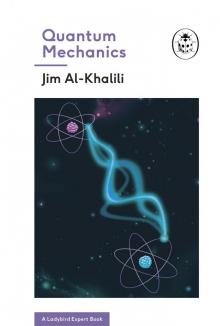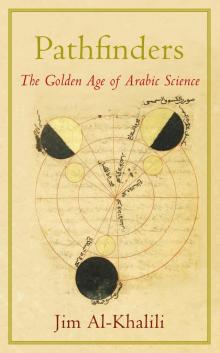- Home
- Jim Al-Khalili
Pathfinders
Pathfinders Read online
JIM AL-KHALILI
Pathfinders
The Golden Age of Arabic Science
ALLEN LANE
an imprint of
PENGUIN BOOKS
ALLEN LANE
Published by the Penguin Group
Penguin Books Ltd, 80 Strand, London WC2R 0RL, England
Penguin Group (USA) Inc., 375 Hudson Street, New York, New York 10014, USA
Penguin Group (Canada), 90 Eglinton Avenue East, Suite 700, Toronto, Ontario,
Canada M4P 2Y3 (a division of Pearson Canada Inc.)
Penguin Ireland, 25 St Stephen’s Green, Dublin 2, Ireland (a division of Penguin Books Ltd)
Penguin Group (Australia), 250 Camberwell Road, Camberwell, Victoria 3124, Australia
(a division of Pearson Australia Group Pty Ltd)
Penguin Books India Pvt Ltd, 11 Community Centre, Panchsheel Park,
New Delhi – 110 017, India
Penguin Group (NZ), 67 Apollo Drive, North Shore 0632, New Zealand
(a division of Pearson New Zealand Ltd)
Penguin Books (South Africa) (Pty) Ltd, 24 Sturdee Avenue, Rosebank 2196, South Africa
Penguin Books Ltd, Registered Offices: 80 Strand, London WC2R 0RL, England
www.penguin.com
First published 2010
Copyright © Jim Al-Khalili, 2010
The moral right of the author has been asserted
All rights reserved.
Without limiting the rights under copyright reserved above, no part of this publication may be reproduced, stored in or introduced into a retrieval system, or transmitted, in any form or by any means (electronic, mechanical, photocopying, recording or otherwise) without the prior written permission of both the copyright owner and the above publisher of this book
ISBN: 978-0-14-196501-7
To Julie
He who finds a new path is a pathfinder, even if the trail has to be found again by others; and he who walks far ahead of his contemporaries is a leader, even though centuries pass before he is recognized as such.
Nathaniel Schmidt, Ibn Khaldūn
Contents
List of Figures
List of Plates
Preface
A Note on Names, Pronunciations, Spellings and Dates
A Note on the Term ‘Arabic Science’
1. A Dream of Aristotle
2. The Rise of Islam
3. Translation
4. The Lonely Alchemist
5. The House of Wisdom
6. Big Science
7. Numbers
8. Algebra
9. The Philosopher
10. The Medic
11. The Physicist
12. The Prince and the Pauper
13. Andalusia
14. The Marāgha Revolution
15. Decline and Renaissance
16. Science and Islam Today
Notes
Glossary of Scientists
Timeline: The Islamic World from Antiquity to the Beginning of the Modern World
Index
List of Figures
Map 1. The Abbasid Caliphate at the beginning of the Ninth Century.
Map 2. The Middle East and Maghrib, towards the end of the Eleventh Century.
Fig. 1. Schematic map of early Abbāsid Baghdad. Source: Journal of the Economic and Social History of the Orient, 9/1–2 (November 1966).
Fig. 2. Round City projected onto a map of modern Baghdad.
Fig. 3. An ancient Chinese method for proving Pythagoras’ theorem.
Fig. 4. The evolution of Hindu-Arabic numerals.
Fig. 5. The first use of a decimal point, in The Book of Chapters on Hindu Arithmetic by al-Uqlīdisi.
Fig. 6. An example of a geometric problem requiring the solution of a quadratic equation, taken from Euclid’s Elements (Book Two, Proposition Eleven).
Fig. 7. Ibn Sahl’s diagram showing the law of refraction of light (through a plano-convex lens) for the very first time. Source: Isis, 81/3 (September 1990).
Fig. 8. The difference between the Greeks’ version of the law of refraction and the correct one described by Ibn Sahl.
Fig. 9. Ibn Mu’ādh’s method for calculating the height of the atmosphere.
Fig. 10. Conic sections.
Fig. 11. Al-Bīrūni’s method for measuring the height of a mountain by geometric means.
Fig. 12. Al-Bīrūni’s method for calculating the circumference of the earth.
Fig. 13. The Ptolemaic model of planetary motion around the earth.
Fig. 14. Comparison between diagrams of Copernicus and al-Tūsi
Fig. 15. The origin of the trigonometric sine of an angle as described by Hindu mathematicians.
List of Plates
1. Abbasid Caliph Harūn al-Rashīd and King Charlemagne, oil painting by Julius Koeckert (1827–1918). (Maximilianeum Foundation, Munich)
2. Hārūn al-Rashīd and the barber in a Turkish bath, fifteenth-century oil painting. (British Library, London, UK/ © British Library Board. All Rights Reserved/The Bridgeman Art Library)
3. The author’s great-great-great uncle, Muhammad Al-Khalili.
4. The author’s paternal grandfather, Merza Muhammad Sādiq Al-Khalili.
5. Members of the Al-Khalili clan in Najaf, 1950.
6. Baghdad’s al-Rashīd Street during a flood, 1950.
7. The Baghdad district of Karradat Merriam.
8. The author and his brother, mid 1960s.
9. The author as a child with his family, 1971.
10. The author during his last year of primary school in Saddat al-Hindiyya.
11. The ruins of the eighth-century Abbāsid Palace of Ukhaidhir, south of Baghdad. (alimdi.net/photographersdirect.com)
12. The ruins of the tenth-century palace-city complex Medinat al-Zahrā’, outside Córdoba. (Medjai)
13. The spiral cone minaret of the Sāmarra mosque. (Thomas J. Abercrombie/Getty Images)
14. Brass astrolabe from Saragossa (c. 1079–80). (Germanisches Nationalmuseum, Nuremberg (Nuernberg), Germany/The Bridgeman Art Library)
15. Description of the eye in Hunayn ibn Ishāq’s Ten Treaties on the Eye. (The Art Archive/Kharbine-Tapabor/Boistesselin)
16. A trickster in eleventh-century Baghdad; thirteenth-century painting. (Institute of Oriental Studies, St Petersburg, Russia/The Bridgeman Art Library)
17. Page from the Canon of Medicine by Ibn Sīna. (Wellcome Library, London)
18. Medieval Muslim surgical instruments, from Kitab al-Tasrīf.
19. Eleventh-century Balkhi-style map of northern Iraq. (The Art Archive/National Library Cairo/Gianni Dagli Orti)
20. Al-Idrīsi’s twelfth-century map of the world.
21. Ptolemy’s geocentric universe as it appears in the Almagest.
22. Copernicus’ heliocentric universe. (Mansell/Getty Images)
23. Diagram of a solar eclipse, from an eleventh-century manuscript of al-Karkhi. (The Art Archive/Kharbine-Tapabor/Photo Boistesselin)
24. Ibn al-Shātir’s sundial, Umayyad Mosque, Damascus. (Billbl)
25. A map from the Book of Routes and Provinces.
26. The Banū Mūsa brothers’ self-trimming lamp. (The Art Archive/National Library Cairo/Gianni Dagli Orti)
27. The Elephant Clock of al-Jazari.
28. The inner workings of the Elephant Clock.
29. Diagram of a system for pumping water into a basin, from the Book of Knowledge of Ingenious Mechanical Devices, by al-Jazari (1206). (Topkapi Palace Museum, Istanbul, Turkey/The Bridgeman Art Library)
30. Al-Birūni’s mountain, from which he measured the circumference of the earth.
31. The campus of King Abdullah University of Science and Technology (KAUST), Jeddah. (Matin Durrani/‘Buying success, Saudi style’,
Physics World, November 2009)
Preface
Sargon, king of Akkad, overseer of Ishtar, king of Kish, anointed priest of Anu, king of the country; he defeated Uruk and tore down its walls. Lugalzaggisi, king of Uruk, he captured in this battle, and brought him in a dog collar to the gate of Enlil.
Ancient text
An hour’s drive south of Baghdad lies the town of Hindīyya. This was where I spent my last few happy teenage years in Iraq before leaving for good in 1979. The town takes its name from the Hindīyya Barrage, which was built across the Euphrates in 1913 by the soon to be departing Ottomans. I have an abiding and powerful memory of this bridge. On cool autumn days I would skip afternoon school with my three best friends, Adel, Khalid and Zahr il-Dīn, and walk across the Barrage to the riverside tourist resort on the opposite bank. We would buy a six-pack of Farīda beer and sit down by the water discussing football, philosophy, movies and girls.
Those happy days contrast dramatically with a second powerful image that is seared into my memory and which took place during the first Gulf War of 1991. I remember watching a CNN news report showing footage of a gun battle in Hindīyya in which a lone and terrified woman was trapped in crossfire while walking across the Barrage. For most viewers this would have been just another scene depicting the horrors of war in a far-off land. But for me, instantly recognizing the setting, it suddenly brought home the reality of the plight of the country I had left behind twelve years earlier. I had walked past the spot where this helpless woman now stood frozen in terror dozens of times.
But that was a world away. As I write, I have yet to return to Iraq. I say ‘as I write’ for I have not ruled out a brief visit at some point in the future when, coward that I am, I deem it safe enough.
The year I left Iraq was a momentous one in the Islamic world. In 1979 Anwar Saddat of Egypt and Israel’s Menachem Begin signed a peace treaty in Washington, the first Islamic republic was created in Iran after the deposed shah fled to Cairo, the holy city of Mecca witnessed a gun battle to put down a fundamentalist insurrection following the killing of hundreds of pilgrims, the Soviet Union invaded Afghanistan and the Iranian hostage crisis began in the US embassy in Tehran. During all this turmoil, Saddam Hussein had taken over the presidency of Iraq from Field Marshal Muhammad Hassan al-Bakr, thus making life a great deal grimmer for the vast majority of the population there. My family and I arrived in Margaret Thatcher’s Britain at the end of July – exactly two weeks after Saddam had come to power. We had escaped just in time, as it turned out, for within months he had declared war on Iran. Had we not left that summer, my brother and I would undoubtedly have been conscripted to fight in that pointless and terrible conflict and I doubt that I would have lived to tell the tale. Having a British mother and a Shi’a Muslim father of Persian descent who had flirted with the Iraqi Communist movement in the 1950s marked my brother and me as ‘undesirables’, and certainly expendable frontline fodder.
And life in Iraq seems to have gone downhill ever since. Things have changed there dramatically since my childhood in the 1960s and 1970s when life for a kid from a middle-class background was comfortable and relatively easy. My father, a British educated electrical engineer, had served as an officer in the Iraqi air force. His various postings around the country meant that we were used to moving house regularly. But in the early 1970s, the ruling Ba’ath party decreed that any Iraqis with British wives were suddenly no longer to be trusted in the armed services. So, having reached the rank of major, he now had to find work as a civilian for the first time in his adult life. He soon landed a job as the head of engineering at Ma’mal al-Harīr, a chemical firm in Hindīyya that produced artificial rayon fibres. We lived in Baghdad for a few years before eventually moving to Hindīyya to spare my father the daily commute. This was fine with me. I made friends quickly, set up my new football team: the Rayon Dynamos (I still have the tatty number 9 shirt I wore) and, together with my brother, would tune in to the BBC World Service to catch the English football scores on ‘Sports Report’ on Saturdays. Actually, the World Service was pretty much a constant background in our house. When possible, I would make regular visits to the British Council’s library in Baghdad for my supply of English books. And I grew up knowing that living under a dictatorship was bearable, as long as you kept your head down and never criticized the government or the Ba’ath Party, even in private.
A fun day out for my family and me was to visit the Hanging Gardens of Babylon, an hour’s drive south-east of Hindīyya. The ruins of this mythical place held no great mystique as I had often trudged around the site on school trips. But despite the less than impressive ruins and my indifference born of familiarity, the excitement of a day away from class never lost its appeal, and the site still radiated a powerful aura that whispered of past glories too ancient for me to comprehend. Once, while on a family picnic there when I was in my early teens, we came across two chunks of clay brick, each the size of a fist and each clearly marked with ancient cuneiform writing on one surface. It is still a source of a long-running and good-natured family dispute as to whether it was my brother, my mother or I who actually picked up these bricks. In any event, my mother hid them in the bottom of our food hamper and we smuggled them back home.
This probably sounds like an outrageous case of archaeological theft. Surely we should have handed over such national treasures to the local authorities or, probably more sensibly, to the Iraqi Museum in Baghdad. But we kept them. In our defence, similar cuneiform-etched Babylonian bricks were strewn among the rubble all around us. And in comparison with the later damage wrought on the ruins of ancient Babylon – first by Saddam Hussein’s astonishingly vulgar rebuilding of the Ishtār Gate in the 1980s, and more recently by the US forces in 2003 who levelled a whole section of one of the world’s most precious archaeological sites to create a landing area for helicopters and a parking lot for heavy military vehicles – our theft seems pretty tame.
It was only recently that I asked an acquaintance, Irvine Finkle, the Curator of Ancient Mesopotamia at the British Museum, to take a look at the two bricks. He confirmed that they date back to the seventh century BCE and the reign of King Nebuchadnezzar II, when the Hanging Gardens were built. Apparently, the symbols are fragments of a common inscription that reads: ‘Nebuchadnezzar, King of Babylon, who provides for Esagila and Ezida [the temples of two Babylonian gods Marduk and Nabu], the eldest son of Nabopolassar’.
The seventh century BCE may sound quite ancient to Europeans, and even more so to Americans, but by Iraqi archaeological standards the period of Nebuchadnezzar’s reign is practically the Middle Ages. It is sometimes hard to imagine that the heritage of those struggling to lead a semblance of normal life in today’s Iraq stretches back over seven thousand years, to the birth of some of the very first civilizations on earth. Archaeologists have dated the remains of the Ubaid culture in southern Iraq to the middle of the sixth millennium BCE; and the succeeding Uruk civilization, which saw the invention of the wheel, as well as such vital technical advances as the fusion of metals, the potter’s wheel, the seal, the brick mould and the temple plan, to around 4100 BCE. And it was in Uruk that an invention – possibly even more important than the wheel – was made. For it was here that writing first appeared.
The rest, as they say, is history.
The first powerful ancestor of today’s indigenous Arab people of Iraq was Sargon, Semite king of the Akkadians, who conquered the Sumerians in the twenty-fourth century BCE. Very little is known about Sargon, but it is believed that he founded a new capital, Akkad, not far from today’s Baghdad. Within a short time his empire extended from the Mediterranean in the west to Persia in the east and he would take the title ‘King of the Four Parts of the World’.
The Akkadians were followed by the dynasty of Ur. It is estimated that the city of Ur in southern Iraq had grown (by around 2000 BCE) to become the largest in the world, with a population of more than sixty thousand. It is from this city that Abraham, patriarch
of the three great monotheistic religions of Judaism, Christianity and Islam, is supposed to have originated.
The first Babylonian dynasty began not long after this, during which we encounter the greatest of all the ancient kings of Iraq, Hammurabi, who reigned for more than forty years (1792–1750 BCE). It is during his rule that we find the world’s first schools as well as the earliest written legal code. Of all the great rulers who followed Hammurabi, and there were many, none would come close to his achievements for a thousand years, until the Assyrian king, Ashurbanipal, founder of the great library of Nineveh near the modern city of Mosul in the north of the country.
The decline of Iraq’s self-rule began several hundred years before the birth of Christ and marked the beginning of more than two millennia of almost uninterrupted outside occupation; by the Persians, Greeks, Mongols, Turks and, briefly – between 1917 and 1921 – the British, after which the modern state of Iraq was born. The great Abbāsid Empire, which lasted from 750 to 1258 CE, should certainly not be regarded as an occupying power. For long periods, however, its caliphs were mere puppets of foreign dynasties, notably the Persian Buyids and the Turkish Seljuks in the tenth and eleventh centuries.
The earliest Persian rule over the land known as Mesopotamia (from the Greek ‘Land Between Two Rivers’ – the Tigris and Euphrates – which largely corresponds to what is modern Iraq) ended with defeat at the hands of Alexander the Great in 333 BCE. The death of Alexander signalled the division of his great empire among his generals: Egypt for Ptolemy, who ruled from Alexandria, and Asia for Seleucus, who built his new capital, Antioch, in north-west Syria, a city that would later play a vital role in the transfer of scientific knowledge from the Greeks to the Arabs.
By the time of the arrival of Islam in the early seventh century CE, what we now call the Middle East was divided between the Persian and Byzantine empires. But with the spread of this new religion from Arabia, a powerful empire emerged, and with it a flourishing civilization and a glorious golden age.

 Sunfall
Sunfall Quantum Mechanics
Quantum Mechanics Pathfinders
Pathfinders